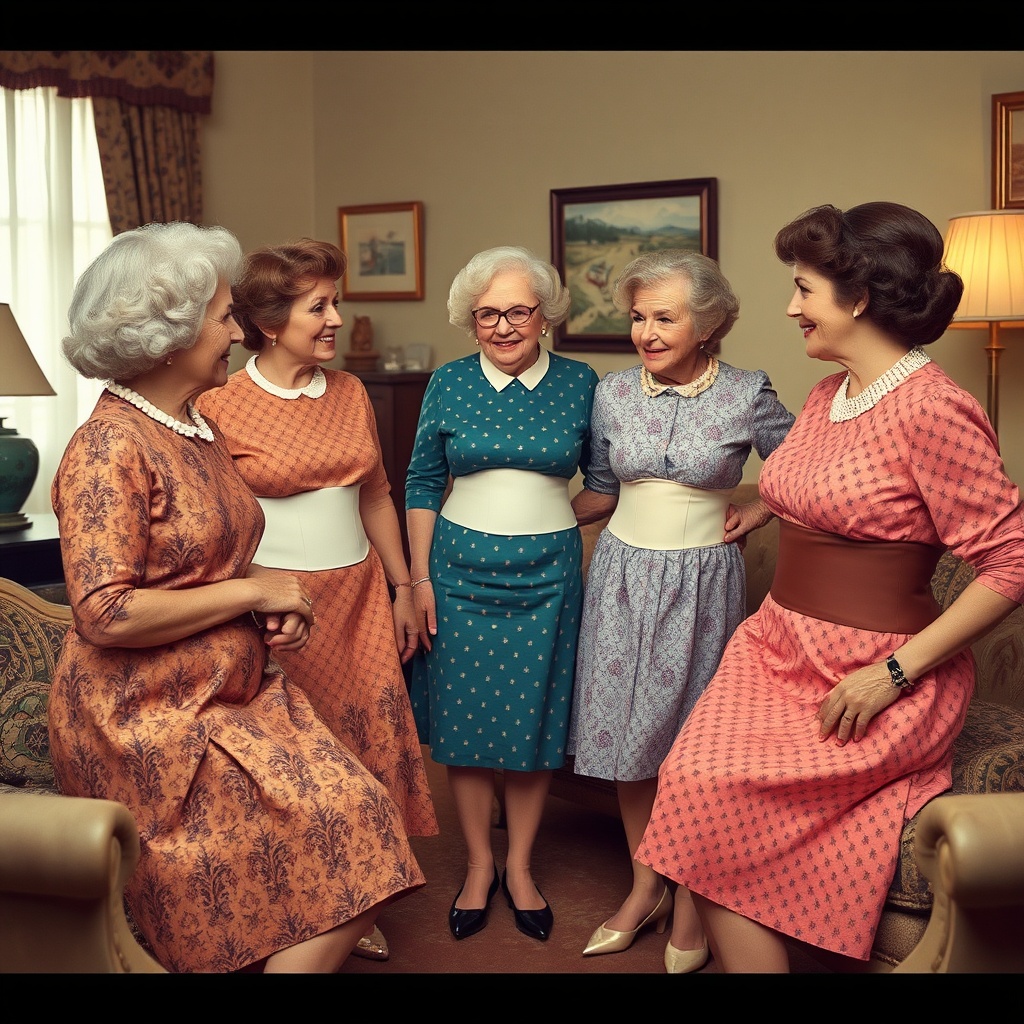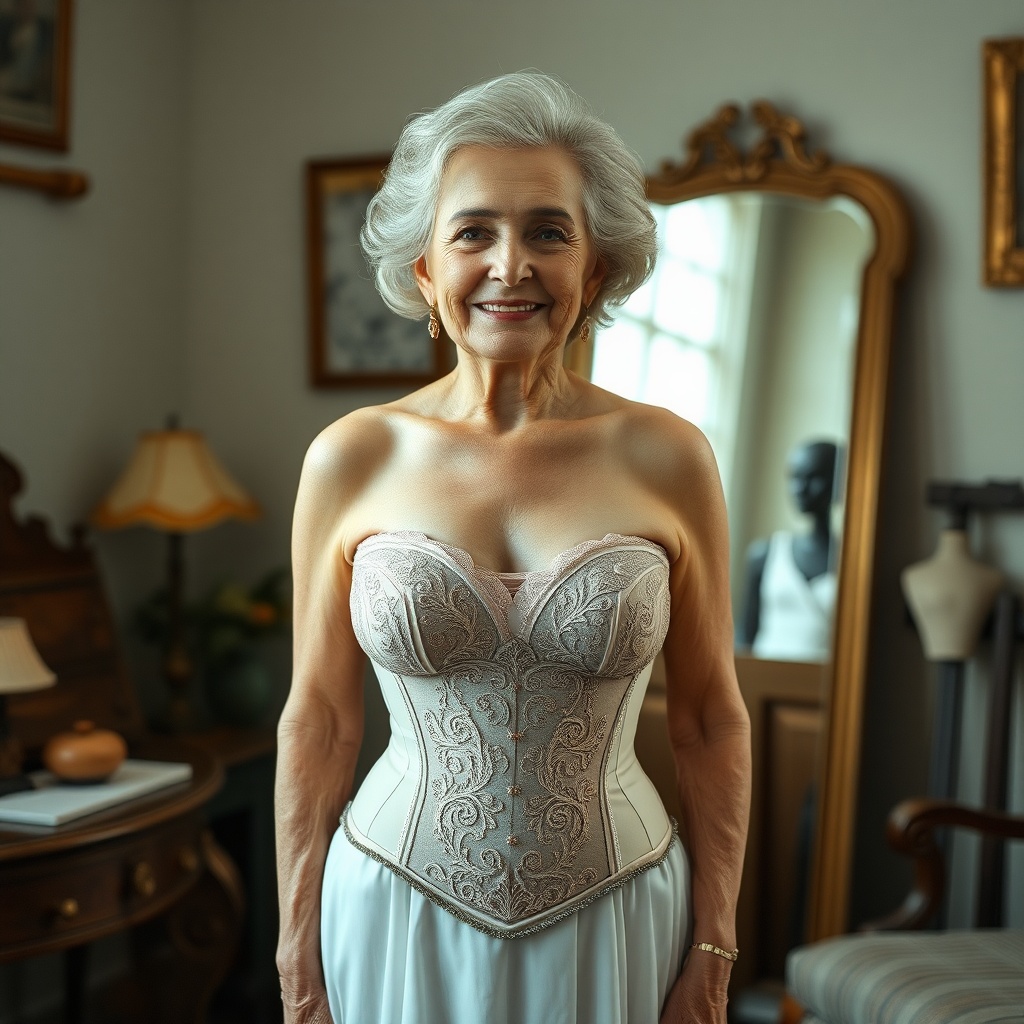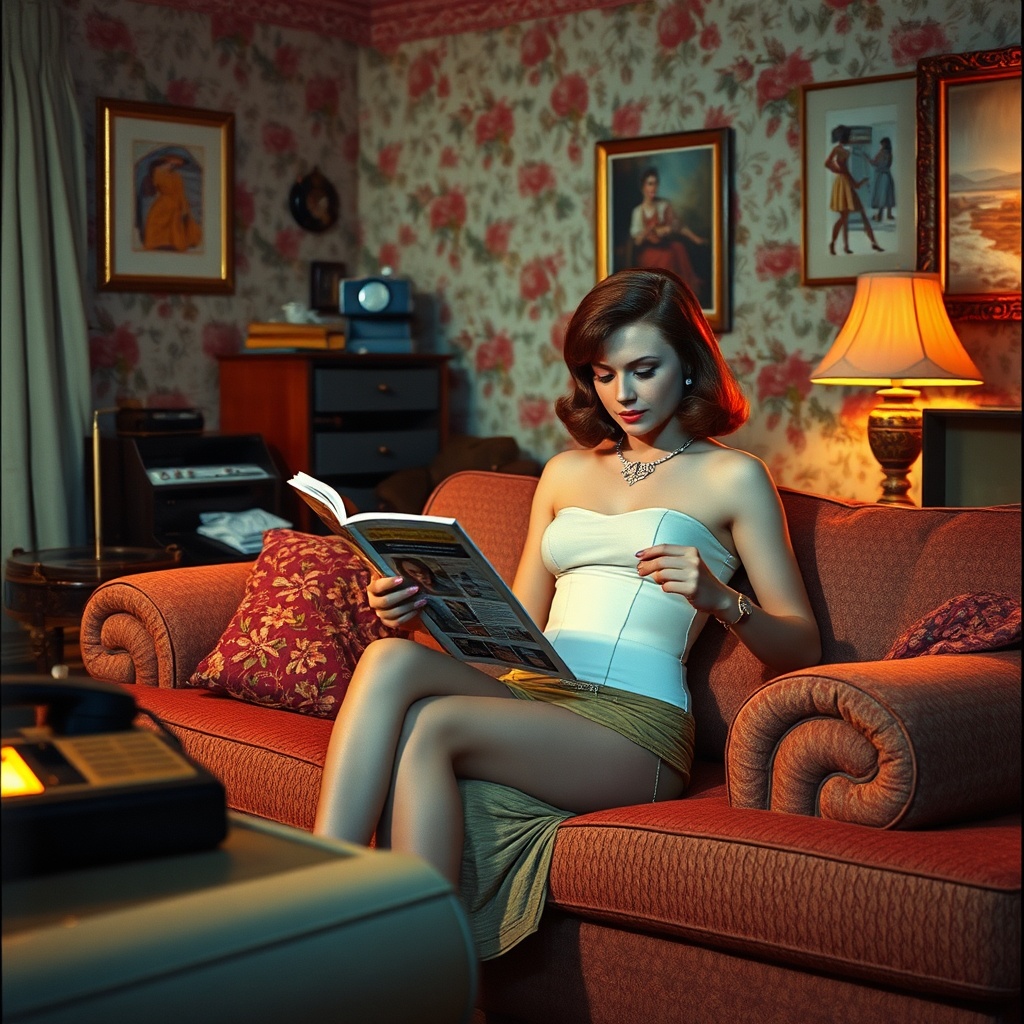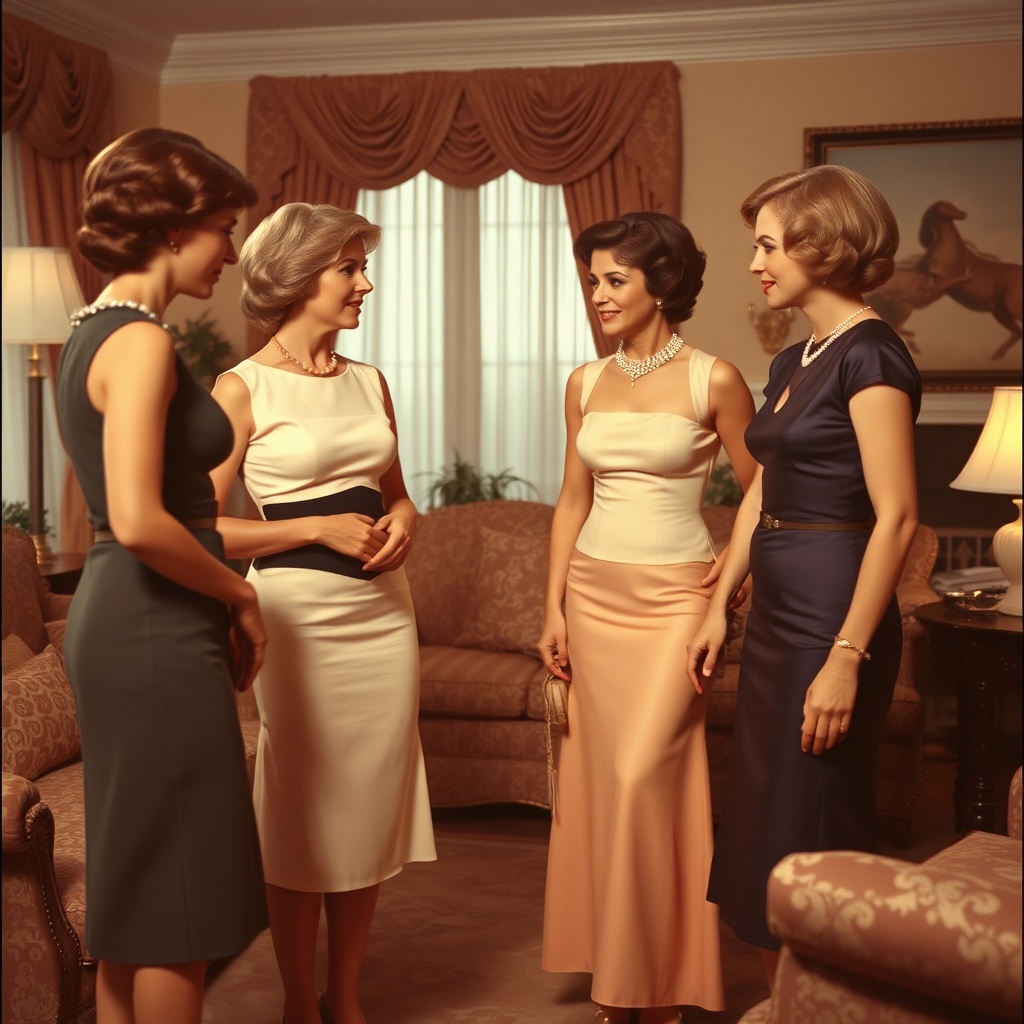Rediscovering the Charm: The Girdle’s Role in 1960s Fashion

Introduction to the Girdle
The girdle, a staple of women’s fashion in the 1960s, was more than just a piece of clothing; it was a symbol of femininity and elegance. With its ability to shape and enhance the female silhouette, the girdle played a crucial role in the fashion of this vibrant decade.
The Evolution of the Girdle
Originally designed in the early 20th century, the girdle underwent significant changes by the 1960s:
- Materials: The 1960s girdles were often made from a combination of nylon, spandex, and lace, offering both comfort and style.
- Design: Girdles featured innovative designs, including hooks, zippers, and even decorative elements.
- Colors: While traditional whites and blacks remained popular, vibrant colors and patterns emerged, allowing for personal expression.
The Girdle in 1960s Fashion
How did the girdle fit into the broader fashion trends of the 1960s? Let’s explore:
- Hourglass Silhouette: The girdle helped create the coveted hourglass figure that defined the decade. Designers like Christian Dior and Yves Saint Laurent emphasized this look in their collections.
- Popular Styles: Girdles were often paired with:
| Style | Details |
|---|---|
| A-Line Dresses | Girdles provided structure to the flowing lines of A-line dresses. |
| Sheath Dresses | These form-fitting styles showcased the smooth lines created by a girdle. |
| Mini Skirts | Worn underneath, girdles complemented the daring mini skirts of the era. |
Social Impact and Cultural Significance
The girdle was more than just a functional garment; it was a cultural icon. Here are some reflections on its social impact:
- Feminine Ideal: The girdle represented the societal expectations of femininity during the 1960s, emphasizing a slim and curvy figure.
- Empowerment: For many women, wearing a girdle was a form of empowerment, allowing them to feel confident and stylish.
Rediscovering the Girdle Today
While fashion has evolved, the charm of the girdle still resonates. For those who wore them in the 1960s, or for new generations discovering vintage styles, the girdle represents a connection to a glamorous past.
The girdle’s role in 1960s fashion is a testament to the timeless elegance of this era. Whether you remember wearing one or are simply fascinated by its history, the girdle remains an enduring symbol of beauty and style.
Beyond the Fabric: How Girdles Redefined Body Image and Confidence

Introduction to the Girdle Revolution
In the vibrant decade of the 1960s, a fashion phenomenon emerged that would not only change the way women dressed but also reshape their perception of body image and confidence. Girdles, once a staple of women’s wardrobes, evolved into symbols of empowerment and elegance. Let’s explore how these garments transcended mere fabric to become tools of self-expression and confidence.
The Origins of Girdles
Girdles have a rich history, originating in the early 20th century. Initially designed to create an hourglass figure, they were often seen as restrictive. However, by the 1960s, girdles began to shift in purpose and perception.
Changing Perspectives on Body Image
As societal norms began to change, so did women’s attitudes towards their bodies. The girdle became a way to embrace curves rather than hide them. Women started to view these garments as a means to enhance their natural shapes, fostering a sense of confidence that was revolutionary for the time.
Girdles in Popular Culture
The influence of media and celebrity culture played a significant role in popularizing girdles during this era. Iconic figures like Marilyn Monroe and Elizabeth Taylor showcased the beauty of well-fitted clothing that accentuated their figures. As these images flooded magazines and film screens, girdles became synonymous with glamour and sophistication.
Practicality Meets Elegance
Despite their sometimes negative reputation for being constrictive, girdles were re-engineered to offer both support and comfort. Innovations in fabric technology allowed for a more breathable, flexible fit, making them a practical choice for everyday wear. This blend of practicality and elegance redefined how women approached their daily attire.
Empowerment Through Fashion
Wearing a girdle became an act of empowerment for many women. It was a way to take control of their appearance and feel confident in their skin. The phrase ‘Dressing for Success’ resonated deeply, as many believed that looking good translated into feeling good.
Interactions and Experiences
How did wearing a girdle impact your confidence? Did you find that it changed the way you carried yourself? Share your experiences and let’s reminisce about the elegance of the past.
The Legacy of Girdles
Today, girdles may seem like a relic of the past, but their legacy lives on. They paved the way for modern shapewear and continue to influence how we perceive body image in fashion. The revolution of the 1960s taught us that clothing could be more than just a covering; it could be a source of strength and self-assurance.
As we reflect on the girdle revolution of the 1960s, it is essential to acknowledge its impact on body image and women’s confidence. Beyond the fabric, girdles served as a reminder of the ability to embrace one’s body and express individuality through fashion.
A Journey Through Time: The Cultural Impact of Girdles in the 1960s

Step back in time with us to the 1960s, a decade bursting with change and cultural evolution. One of the most fascinating aspects of this era was the girdle revolution, a topic that evokes nostalgia and reflection. Let’s explore how girdles shaped not just fashion, but also the very fabric of society during this transformative period.
The Girdle: A Symbol of Femininity
In the 1960s, the girdle was much more than a piece of clothing; it was a symbol of femininity and elegance. Women wore girdles to achieve the coveted hourglass figure, which was celebrated in fashion and media. Can you remember the sensation of slipping into a well-fitted girdle? It was a rite of passage for many young women.
Fashion Trends of the 1960s
The fashion landscape of the 1960s was vibrant and diverse. With designers like Mary Quant and Yves Saint Laurent, styles evolved rapidly.
- Mini skirts – Paired often with girdles for support.
- Sheath dresses – Highlighted the waist, making girdles a must-have.
- Bold prints and colors – Girdles often came in matching designs to complement outfits.
Can you recall any outfits that you loved wearing during this time? The girdle was an essential component in achieving those iconic looks.
Cultural Shifts and the Girdle
The 1960s was a decade of liberation and change. As women began to assert their independence, the girdle faced scrutiny.
- Feminist Movement – Some viewed girdles as symbols of oppression, while others appreciated their role in enhancing beauty.
- Body Positivity – The rise of body positivity challenged traditional beauty standards, leading to a reevaluation of girdles.
- Fashion Freedom – By the end of the decade, many women opted for comfort over constriction, leading to a decline in girdle popularity.
How did these cultural shifts influence your own fashion choices during this time?
Legacy of the Girdle
Today, the girdle is often seen as a relic of the past, yet its legacy remains. It paved the way for modern shapewear, which continues to evolve. Reflecting on the girdle’s impact, we can appreciate how it encapsulated the essence of a decade filled with contradictions: beauty and liberation, tradition and rebellion.
As we conclude this journey through the cultural impact of girdles in the 1960s, we invite you to share your memories. How did girdles influence your life? What stories do you have about fashion during this vibrant decade? The girdle revolution not only defined a style but also an era, and its echoes can still be felt today.
Crafting the Perfect Silhouette: The Art and Science of Girdle Design
Understanding Girdles: More Than Just Shapewear
The girdle, a staple of 1960s fashion, played a vital role in achieving the ideal silhouette. But what makes a girdle truly special? Let’s delve into the fascinating world of girdle design and discover how it combines both art and science.
The Anatomy of a Girdle
Every girdle is crafted with specific elements that contribute to its effectiveness. Here are the key components:
- Materials: Girdles were typically made from elastic, lace, or cotton blends to provide both comfort and support.
- Construction: The design often included reinforced panels, boning, and hooks to maintain structure.
- Fit: A well-fitted girdle is crucial; it should hug the body without causing discomfort.
The Science Behind Support
Girdles aren’t just about aesthetics. They employ a science that focuses on body mechanics:
- Compression: The right amount of compression helps in shaping the waist and hips.
- Posture Alignment: Girdles encourage better posture, providing additional back support.
- Body Contouring: The design strategically smooths out any bulges, giving a seamless look under clothing.
Choosing the Right Girdle
When selecting a girdle, consider the following:
- Body Type: Different styles cater to various body shapes. A-line, hourglass, or pear—there’s a girdle for everyone.
- Occasion: Think about when you’ll wear it. For daily wear, choose something comfortable; for special occasions, opt for a more structured design.
Care and Maintenance
To prolong the life of your girdle:
- Washing: Hand wash in cold water to maintain elasticity.
- Storage: Store flat to avoid creases and damage.
Conclusion: Embracing Elegance
The girdle is not just a garment; it’s a celebration of the female form, combining artistry with scientific design. By understanding its intricacies, you can embrace your elegance with confidence.
From Everyday Wear to Iconic Status: The Transformation of Girdles
Introduction to Girdles in the 1960s
In the 1960s, girdles were more than just garments; they represented a shift in fashion and cultural norms. Let’s explore how these undergarments evolved from everyday wear to symbols of elegance and empowerment.
The Everyday Girdle
Initially, girdles were practical items worn by women to achieve a smooth silhouette under clothing. Do you remember wearing one? Here are some characteristics:
- Supportive Structure: Made from elastic materials, they provided support to the waist and hips.
- Variety of Styles: From high-waisted to mid-thigh, girdles came in many designs.
- Functional Fashion: They were often worn under dresses and skirts, enhancing the overall look.
The Cultural Shift
As the 1960s progressed, societal changes began to influence fashion significantly. Can you recall the moment you first noticed this shift? Here’s how girdles transformed:
- Emphasis on Liberation: The women’s liberation movement encouraged women to embrace their bodies.
- Fashion Icons: Celebrities like Marilyn Monroe and Audrey Hepburn wore girdles, elevating their status.
- Change in Perception: No longer just a functional garment, girdles became a symbol of female empowerment.
The Iconic Status
By the late 1960s, girdles achieved an iconic status. Did you ever feel a sense of pride wearing one? Here are some reasons for this transformation:
- Fashion Statements: Designers began to incorporate girdles into runway shows, showcasing their versatility.
- Media Influence: Magazines and fashion shows featured girdles, making them a statement piece.
- Shift to Modernity: Girdles paved the way for modern shapewear, influencing future generations.
Conclusion: The Legacy of Girdles
Today, girdles hold a nostalgic place in fashion history. What memories do they evoke for you? The evolution from everyday wear to an iconic status illustrates the dynamic nature of fashion. Embrace the memories and stories of the girdle revolution, a testament to elegance and change.
Personal Stories: How Girdles Shaped Women’s Lives in the 1960s
In the 1960s, girdles were more than just undergarments; they were symbols of femininity, societal expectations, and personal identity. For many women, these garments played a crucial role in shaping their lives and experiences. Let’s explore some personal stories that highlight the impact of girdles during this transformative decade.
The Daily Ritual
Mary, 72: “Wearing a girdle was part of my morning routine. It was almost like a ritual. I remember carefully slipping into my girdle, feeling the fabric hug my body. It gave me a sense of control, a way to start my day with confidence. I knew that when I left the house, I was presenting my best self to the world.”
Fashion Statements
Linda, 75: “The 60s were a time of rebellion and change. While many women were burning their bras, I was embracing my girdle. It was an essential part of my fashionable look. I wore it under my pencil skirts, ensuring that everything stayed smooth and fitted. I felt empowered, like I was part of a movement, even if it was different from what the younger generation was doing.”
Body Image and Self-esteem
Joan, 69: “I struggled with my body image throughout my youth. The media portrayed a very specific idea of beauty, and girdles became my secret weapon. They helped me achieve the hourglass figure that I thought was ideal. But, looking back, I realize that they also contributed to my insecurities. I was often uncomfortable, both physically and mentally, but I believed it was necessary to fit in.”
Social and Cultural Influences
Patricia, 74: “In our neighborhood, girdles were a topic of conversation. We shared tips on how to find the perfect fit and the best styles to wear. It was a bonding experience, something that connected us as women. However, as the 60s progressed and the feminist movement gained momentum, I felt the shift. Many of my friends began to reject the girdle, embracing a more natural look, which made me question my choices. Was I conforming to societal expectations or celebrating my femininity?”
Health and Comfort
Elaine, 71: “I had always been a fan of girdles until I started noticing some discomfort. They were meant to shape and support, but sometimes I felt restricted. I remember a particular occasion at a family wedding when I couldn’t wait to take mine off. It made me realize that while they were fashionable, comfort should also be a priority. That was the start of my journey towards more comfortable undergarments.”
These personal stories reflect a broader narrative of the 1960s, a time when girdles symbolized both conformity and rebellion. For many women, they were a tool for self-expression, a means to navigate societal expectations, and a source of both confidence and discomfort. As we reflect on this era, it’s essential to appreciate the complexity of women’s experiences and how they shaped their identities.
The Girdle Comeback: Reviving Vintage Fashion for Today’s Generations
Introduction to the Girdle Comeback
The girdle, once a staple of women’s wardrobes, is making a notable return in today’s fashion scene. During the 1960s, girdles were synonymous with elegance and femininity. As we delve into this revival, let’s explore how today’s generations can embrace vintage styles while making them their own.
The Girdle: A Brief History
Originally designed to shape and support, girdles became popular in the mid-20th century. They were not just undergarments; they were a statement of style and poise. By the 1960s, the girdle had evolved into various styles, from the classic waist cincher to more flexible designs that allowed for comfort without sacrificing elegance.
Understanding the Comeback
So, what is driving this resurgence in girdle fashion? Let’s break it down:
Fashion Cycles: Fashion is cyclical, and what was once old often becomes new again.
Influencers and Celebrities: Many public figures are now showcasing vintage styles, including girdles, on social media.
Body Positivity: The modern movement towards embracing all body types has led to a renewed interest in shapewear that celebrates curves.
How to Incorporate Girdles Today
Ready to give girdles a try? Here are some tips on how to incorporate them into your wardrobe:
| Style | Occasion | Tips |
|---|---|---|
| Classic Girdle | Everyday Wear | Pair with high-waisted skirts for a smooth silhouette. |
| Lace Girdle | Date Night | Layer under a fitted dress for a touch of romance. |
| Sporty Girdle | Casual Outings | Choose a comfortable, breathable fabric for ease of movement. |
Girdles and Confidence
Wearing a girdle can enhance your self-esteem and make you feel more put-together. Remember:
Choose the right fit to ensure comfort.
Experiment with different styles to find what best suits your body shape.
Don’t shy away from colors and patterns that express your personality.
As we revisit the fashion trends of the 1960s, the girdle stands out as a symbol of timeless elegance. Its comeback is not merely about nostalgia; it’s about celebrating body confidence and personal expression. Embrace the girdle revolution and explore how this vintage piece can enhance your wardrobe today.
Fashion Statements: The Girdle as a Symbol of Feminine Empowerment
Understanding the Girdle’s Place in Fashion
The girdle, often viewed as a mere undergarment, played a pivotal role in shaping not just silhouettes but also the very essence of femininity during the 1960s. This era was marked by a profound shift in women’s fashion, where the girdle evolved from a restrictive item to a symbol of empowerment.
The Girdle: A Historical Context
Before diving into its empowering aspects, let’s take a moment to understand the girdle’s origins. Initially introduced in the early 20th century, it was designed to mold the body into the fashionable hourglass figure. However, as the 1960s approached, societal expectations began to change.
Feminine Empowerment Through Fashion
During the 1960s, women started to reclaim their bodies and their narratives. The girdle, once a tool of oppression, gradually became a means of self-expression:
- Body Positivity: Women began to embrace their natural shapes while using girdles to enhance rather than restrict.
- Choice and Control: The girdle was no longer just something to wear; it became a choice that represented autonomy over one’s body.
- Fashion Statements: Many women wore girdles as part of their outfits, showcasing them as fashionable accessories rather than hidden garments.
The Social Impact of the Girdle
As women donned girdles, they were making bold statements:
- Defiance of Norms: By choosing to wear a girdle, women defied the casual, free-flowing styles of the era, asserting their right to wear what made them feel empowered.
- Integration in Pop Culture: Icons like Marilyn Monroe and Audrey Hepburn popularized the girdle, linking it to glamour and sophistication.
Interactive Retrospective: Your Girdle Story
Now, let’s reminisce together. Did you have a favorite girdle from the 1960s? What did it symbolize for you?
Share your thoughts:
- Comfort or Restriction: How did wearing a girdle make you feel?
- Fashion Inspirations: Which celebrities influenced your choice of girdle?
The girdle of the 1960s transformed from a simple undergarment into a powerful symbol of feminine empowerment. It represents the resilience and evolving identity of women as they navigated societal changes. So, as we look back, let’s celebrate the girdle for its role in shaping not just fashion, but also the self-confidence of women everywhere.
The Evolution of Underwear: Girdles and Their Lasting Legacy
Understanding the Girdle
During the mid-20th century, the girdle emerged as a revolutionary garment in women’s fashion. This undergarment wasn’t just about support; it was a symbol of femininity and elegance. How many of you remember the sensation of slipping into a girdle? It was an experience that combined comfort with a touch of glamour.
The Historical Context
The girdle became popular in the 1950s and 1960s as a response to changing fashion trends. With the rise of fitted dresses, women sought a way to achieve that perfect silhouette. The girdle served this purpose remarkably well. Can you recall the styles you wore during that vibrant era? Those were times of bold colors and daring designs!
Construction and Design
Girdles were ingeniously designed to shape the waist and hips. Made from materials like elastic and nylon, they provided the necessary support while allowing for movement. Isn’t it fascinating how fashion can be both functional and aesthetically pleasing? Think back to the intricate lace and satin details that adorned many girdles. They were not just undergarments; they were works of art.
Social Implications
The girdle was more than just a piece of clothing; it represented societal expectations of women. In the 1960s, as women began to embrace liberation, the girdle’s popularity started to wane. Do you remember the shift in attitudes toward women’s fashion? It was a time of transformation and empowerment!
Girdles in Today’s Fashion
Even though girdles may not be as common today, their influence remains. Modern shapewear takes cues from their design, offering similar support without compromising comfort. Have you noticed how fashion evolves yet retains elements from the past? It’s a beautiful cycle!
A Lasting Legacy
The legacy of the girdle continues to impact how we view underwear and body image. They taught us the importance of confidence in one’s appearance. What lessons did you learn from the girdle era? Perhaps it was about embracing your body or finding beauty in every shape.
Reflecting on the girdle revolution invites us to appreciate how fashion serves as a mirror to cultural shifts. As we celebrate the elegance of the past, let’s carry forward the lessons of confidence and self-expression. What memories do you cherish from that time? Share your stories, and let’s keep the conversation alive!
Timeless Trends: Celebrating the Girdle’s Enduring Influence in Modern Style
The 1960s marked a significant turning point in women’s fashion, with the girdle emerging as a symbol of both elegance and constraint. This era saw the girdle transform from a functional garment into an iconic piece of style that shaped contemporary aesthetics.
Understanding the Girdle’s Design
The girdle was designed to enhance the female silhouette, offering support and shaping. Its structure typically included:
– Boning for rigidity
– Elastic materials for comfort
– Lace and decorative elements for a touch of femininity
Throughout the 1960s, many influential figures embraced the girdle, making it a staple in their wardrobes. Consider how celebrities of the time, such as Marilyn Monroe and Audrey Hepburn, showcased the girdle in their iconic looks. Can you recall any memorable outfits from that era?
Transitioning Into Modern Fashion
Fast forward to today, and the influence of the girdle can still be seen in modern clothing. Designers continue to incorporate elements reminiscent of girdles into:
Shapewear: Providing similar support while being more comfortable.
Structured dresses: Often featuring built-in corsetry.
High-waisted styles: Drawing inspiration from the girdle’s shaping techniques.
Embracing Girdle-Inspired Trends
What modern fashion pieces do you own that echo the girdle’s legacy? Perhaps you have a favorite dress or a piece of shapewear that makes you feel confident. Share your thoughts!
The Girdle’s Symbolism
Beyond functionality, the girdle represented a deeper cultural significance. It was a marker of femininity and social status. How do you think these perceptions have evolved over time? Reflect on the ways women’s fashion has changed since the 1960s.
Conclusion: A Nod to Timeless Elegance
As we celebrate the enduring influence of the girdle, it’s essential to appreciate how this once-restrictive garment has paved the way for modern styles that prioritize both elegance and comfort. What do you think the future holds for girdle-inspired fashion?
